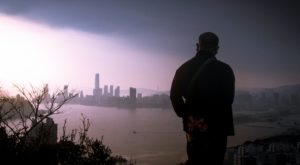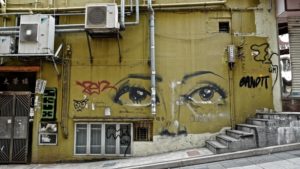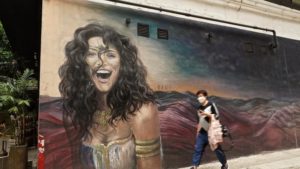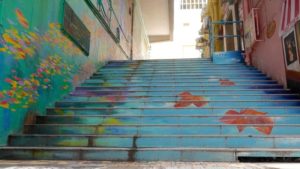You have no items in your cart. Want to get some nice things?
Go shopping
“Are you a tourist?” he asked, setting down a huge bowl of steaming broth in front of me. The base of noodles was topped with bok choy, fish balls, tofu, and a few oblong items I can only describe as Chinese cocktail weenies. Eat like a local: That’s my motto, for better or worse.
It would’ve been a perfectly fair question a couple years ago. I am, after all, a big old white guy – a gweilo – with a sweaty brow and a camera that has more buttons than I know what to do with. To complete the cliché, I have a non-regional American accent, though strictly speaking I’m not American. This is a secret get-out-of-jail-free card for us Canadians. Whenever we offend people on our travels, the locals shake their heads and say, Bloody rude Americans! No one ever thinks to blame Canadians.
The question was asked by the pop of a mom and pop shop where I went for lunch in Kennedy Town, an area of Hong Kong that seldom blips on the tourist radar except for those on a pilgrimage to the semifamous wall of trees along Forbes Street. I gave Pop a sideways look, and we both laughed as he saw the absurdity of his question. I didn’t even need to answer: No, of course I’m not a tourist.
That’s because, during this pandemic, there are no tourists in Hong Kong – not the usual kind, anyway. Although crowds have certainly thinned since early 2020, Hong Kong never became a lockdown ghost town along the lines of London or New York. Public transit continued to run, major shopping districts such as Causeway Bay and Kowloon’s Nathan Road never really stopped buzzing, and restaurants have returned to near-full capacity.
But call it an early night because bars and nightclubs remain shuttered, notably in popular Lan Kwai Fong – shortened to LKF by local expats, especially after they’ve had a few – an area where packed-in partiers would mingle more intimately into the wee hours than health officials were willing to tolerate.
With minimal social restrictions blocking the way, the ever-industrious Hong Kongers have responded to the lack of imported tourists by becoming rather active tourists here themselves. Domestic tourism is not a new idea, of course, but in pandemic times it’s often the only idea, and the Hong Kong Tourism Board ran ad campaigns promoting it.
While Hong Kongers are encouraged to explore locally, they are equally discouraged from traveling abroad. In addition to global travel restrictions, there’s a daunting quarantine for returning residents. As of this writing, it’s three weeks wearing a wristband monitor and pacing the floor in a government approved hotel at one’s own expense – assuming you had tested negative upon arrival at the airport.
It may be presumptuous to include myself among the homegrown tourists, but I am a visa holder and I like to find the time to explore. Whenever I’m in the mood for an inspiring urban wander, I’ll hop on a bus to Sheung Wan or Sai Ying Pun. These two connected neighbourhoods overflow with achingly Instagrammable coffee shops and tiny boutiques along with a dose of vintage grit. Joined at the hipster, as it were.
Like much of Hong Kong Island, Sheung Wan and Sai Ying Pun are built on a serious hillside strewn with gleaming (and not-so-gleaming) high-rises, with broad stone staircases going in all directions like an Escher drawing. In contrast, the architecture of the older, low-rise buildings runs the gamut from bland to godawful.
This is a gift to street artists, who treat these exterior walls as free canvases, turning the area’s maze of one-way streets and alleyways into a meandering open-air gallery. The most ambitious work is created during annual festivals by well-known artists from around the world. In other locations, colourful family-friendly murals commissioned by restaurants and businesses enliven entire sides of indifferent buildings and create instant landmarks.


Aging hipster that I am, I like to go beyond the official street art and Disneyfied installations and venture farther into the alleys where the wild things are. This is the breeding ground for politically and sexually charged stuff along with weird, dashed-off pieces, often with graffiti scrawled around the edges like encroaching weeds. Here I find the work of locally famous artists such as Lousy – Hong Kong’s answer to Keith Haring – and others whose instantly recognisable images inhabit the clever nooks and dark spaces.
Each time I visit, my mental sketch of the area fills in more detail. I’ll notice the funky sign over an abandoned print shop, the gnarled roots of banyan trees by an elementary school, a new chai latte place, community gardens with outdoor exercise equipment and a mural I could’ve sworn wasn’t there last week.

While I puff up and down stairs taking pictures of painted walls, many of Hong Kong’s other 7.5 million inhabitants embark on their own missions of discovery and rediscovery, seeing their city as if through the fresh, fascinated eyes of newcomers. Hikers roam scenic mountain trails for free. And for the price of a ferry ticket they can spend an idyllic day at the beaches and seafood bars on the many outlying islands.
The irony is that popular nature trails such as Dragon’s Back have become clogged with local hikers, forcing more people to veer off pathways and damage the fragile environment. Littering has increased, and discarded face masks have been seen clinging to shrubbery like strange aqua-blue flowers.
Having more locals out and about enjoying fresh air and seafood is wonderful but does little to address the devastation brought on by the collapse of international travel. The effects are magnified in a dot of a place like Hong Kong, a place defined by global business. One result is that it took massive government action to bail out Cathay Pacific, an airline with no such thing as a domestic flight.
Meanwhile, upscale hotels with spectacular city and harbour views, now mostly emptied of lucrative business travellers, hang onto economic life by offering staycation packages at prices most locals could not otherwise afford.
The economic squeeze has been felt at ground level, too, especially among small retailers already reeling from the disruption caused by 2019’s pro-democracy protests. During one of my Sheung Wan wanders, I happened upon a leather-goods boutique. They’d been operating on razor-thin margins and were now forced to close down, saying they simply could not withstand a year filled with protests followed by a year or more of COVID-19.
One positive outcome of this pandemic is that more Hong Kongers are strapping on hiking shoes and discovering their own backyard; meanwhile, others won’t venture much beyond the escalators at glitzy shopping centres. I’m somewhere in the middle, exploring the urban wilds while remaining within striking distance of cosy coffee shops with free Wi-Fi.
Perhaps I ought to return to that Kennedy Town noodle shop one day soon – and I’ll order something without wieners next time. Then I’ll give Pop a different answer when he asks, “Are you a tourist?”
“Why, yes I am,” I’ll say. “Are you?”
Paul Ruta
Paul Ruta is a Canadian writer living in Hong Kong with his wife and a geriatric tabby called Zazu; his kids live on Zoom. Recent work appears in Cheap Pop, F(r)iction, Reflex Press, Ghost Parachute and Smithsonian Magazine. He reads for No Contact magazine.
- Web |
- More Posts(1)




